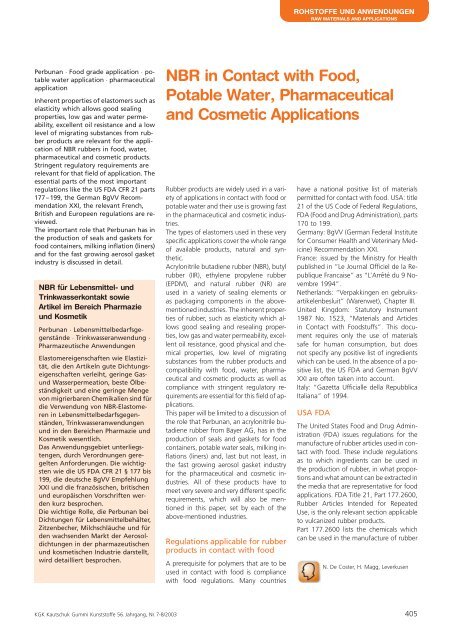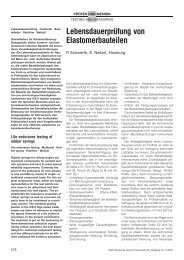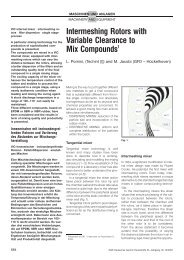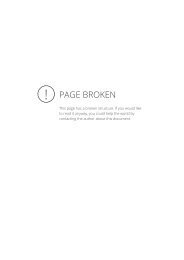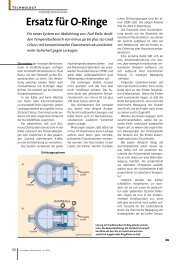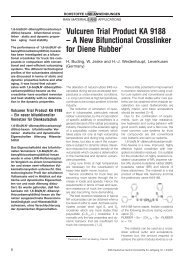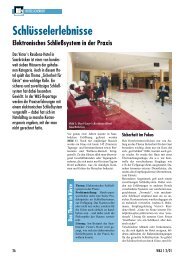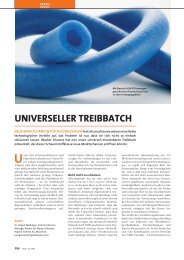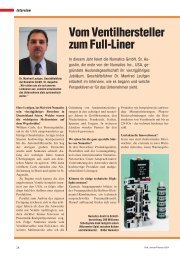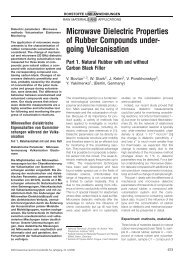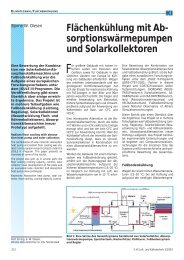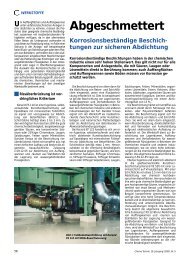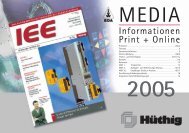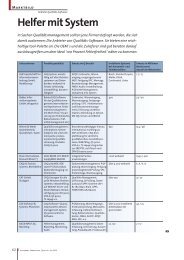NBR in Contact with Food, Potable Water ... - Plastverarbeiter
NBR in Contact with Food, Potable Water ... - Plastverarbeiter
NBR in Contact with Food, Potable Water ... - Plastverarbeiter
Create successful ePaper yourself
Turn your PDF publications into a flip-book with our unique Google optimized e-Paper software.
Perbunan <strong>Food</strong> grade application potable<br />
water application pharmaceutical<br />
application<br />
Inherent properties of elastomers such as<br />
elasticity which allows good seal<strong>in</strong>g<br />
properties, low gas and water permeability,<br />
excellent oil resistance and a low<br />
level of migrat<strong>in</strong>g substances from rubber<br />
products are relevant for the application<br />
of <strong>NBR</strong> rubbers <strong>in</strong> food, water,<br />
pharmaceutical and cosmetic products.<br />
Str<strong>in</strong>gent regulatory requirements are<br />
relevant for that field of application. The<br />
essential parts of the most important<br />
regulations like the US FDA CFR 21 parts<br />
177 –199, the German BgVV Recommendation<br />
XXI, the relevant French,<br />
British and Europeen regulations are reviewed.<br />
The important role that Perbunan has <strong>in</strong><br />
the production of seals and gaskets for<br />
food conta<strong>in</strong>ers, milk<strong>in</strong>g <strong>in</strong>flation (l<strong>in</strong>ers)<br />
and for the fast grow<strong>in</strong>g aerosol gasket<br />
<strong>in</strong>dustry is discussed <strong>in</strong> detail.<br />
<strong>NBR</strong> für Lebensmittel- und<br />
Tr<strong>in</strong>kwasserkontakt sowie<br />
Artikel im Bereich Pharmazie<br />
und Kosmetik<br />
Perbunan Lebensmittelbedarfsgegenstände<br />
Tr<strong>in</strong>kwasseranwendung<br />
Pharmazeutische Anwendungen<br />
Elastomereigenschaften wie Elastizität,<br />
die den Artikeln gute Dichtungseigenschaften<br />
verleiht, ger<strong>in</strong>ge Gasund<br />
Wasserpermeation, beste Úlbeständigkeit<br />
und e<strong>in</strong>e ger<strong>in</strong>ge Menge<br />
von migrierbaren Chemikalien s<strong>in</strong>d für<br />
die Verwendung von <strong>NBR</strong>-Elastomeren<br />
<strong>in</strong> Lebensmittelbedarfsgegenständen,<br />
Tr<strong>in</strong>kwasseranwendungen<br />
und <strong>in</strong> den Bereichen Pharmazie und<br />
Kosmetik wesentlich.<br />
Das Anwendungsgebiet unterliegstengen,<br />
durch Verordnungen geregelten<br />
Anforderungen. Die wichtigsten<br />
wie die US FDA CFR 21 § 177 bis<br />
199, die deutsche BgVV Empfehlung<br />
XXI und die französischen, britischen<br />
und europäischen Vorschriften werden<br />
kurz besprochen.<br />
Die wichtige Rolle, die Perbunan bei<br />
Dichtungen für Lebensmittelbehälter,<br />
Zitzenbecher, Milchschläuche und für<br />
den wachsenden Markt der Aerosoldichtungen<br />
<strong>in</strong> der pharmazeutischen<br />
und kosmetischen Industrie darstellt,<br />
wird detailliert besprochen.<br />
ROHSTOFFE UND ANWENDUNGEN<br />
RAW MATERIALS AND APPLICATIONS<br />
<strong>NBR</strong> <strong>in</strong> <strong>Contact</strong> <strong>with</strong> <strong>Food</strong>,<br />
<strong>Potable</strong> <strong>Water</strong>, Pharmaceutical<br />
and Cosmetic Applications<br />
Rubber products are widely used <strong>in</strong> a variety<br />
of applications <strong>in</strong> contact <strong>with</strong> food or<br />
potable water and their use is grow<strong>in</strong>g fast<br />
<strong>in</strong> the pharmaceutical and cosmetic <strong>in</strong>dustries.<br />
The types of elastomers used <strong>in</strong> these very<br />
specific applications cover the whole range<br />
of available products, natural and synthetic.<br />
Acrylonitrile butadiene rubber (<strong>NBR</strong>), butyl<br />
rubber (IIR), ethylene propylene rubber<br />
(EPDM), and natural rubber (NR) are<br />
used <strong>in</strong> a variety of seal<strong>in</strong>g elements or<br />
as packag<strong>in</strong>g components <strong>in</strong> the abovementioned<br />
<strong>in</strong>dustries. The <strong>in</strong>herent properties<br />
of rubber, such as elasticity which allows<br />
good seal<strong>in</strong>g and reseal<strong>in</strong>g properties,<br />
low gas and water permeability, excellent<br />
oil resistance, good physical and chemical<br />
properties, low level of migrat<strong>in</strong>g<br />
substances from the rubber products and<br />
compatibility <strong>with</strong> food, water, pharmaceutical<br />
and cosmetic products as well as<br />
compliance <strong>with</strong> str<strong>in</strong>gent regulatory requirements<br />
are essential for this field of applications.<br />
This paper will be limited to a discussion of<br />
the role that Perbunan, an acrylonitrile butadiene<br />
rubber from Bayer AG, has <strong>in</strong> the<br />
production of seals and gaskets for food<br />
conta<strong>in</strong>ers, potable water seals, milk<strong>in</strong>g <strong>in</strong>flations<br />
(l<strong>in</strong>ers) and, last but not least, <strong>in</strong><br />
the fast grow<strong>in</strong>g aerosol gasket <strong>in</strong>dustry<br />
for the pharmaceutical and cosmetic <strong>in</strong>dustries.<br />
All of these products have to<br />
meet very severe and very different specific<br />
requirements, which will also be mentioned<br />
<strong>in</strong> this paper, set by each of the<br />
above-mentioned <strong>in</strong>dustries.<br />
Regulations applicable for rubber<br />
products <strong>in</strong> contact <strong>with</strong> food<br />
A prerequisite for polymers that are to be<br />
used <strong>in</strong> contact <strong>with</strong> food is compliance<br />
<strong>with</strong> food regulations. Many countries<br />
have a national positive list of materials<br />
permitted for contact <strong>with</strong> food. USA: title<br />
21 of the US Code of Federal Regulations,<br />
FDA (<strong>Food</strong> and Drug Adm<strong>in</strong>istration), parts<br />
170 to 199.<br />
Germany: BgVV (German Federal Institute<br />
for Consumer Health and Veter<strong>in</strong>ary Medic<strong>in</strong>e)<br />
Recommendation XXI.<br />
France: issued by the M<strong>in</strong>istry for Health<br />
published <strong>in</strong> “Le Journal Officiel de la Republique<br />
Francaise” as “L’Arrêté du 9 Novembre<br />
1994”.<br />
Netherlands: “Verpakk<strong>in</strong>gen en gebruiksartikelenbesluit”<br />
(Warenwet), Chapter III.<br />
United K<strong>in</strong>gdom: Statutory Instrument<br />
1987 No. 1523, “Materials and Articles<br />
<strong>in</strong> <strong>Contact</strong> <strong>with</strong> <strong>Food</strong>stuffs”. This document<br />
requires only the use of materials<br />
safe for human consumption, but does<br />
not specify any positive list of <strong>in</strong>gredients<br />
which can be used. In the absence of a positive<br />
list, the US FDA and German BgVV<br />
XXI are often taken <strong>in</strong>to account.<br />
Italy: “Gazetta Ufficialle della Repubblica<br />
Italiana” of 1994.<br />
USA FDA<br />
The United States <strong>Food</strong> and Drug Adm<strong>in</strong>istration<br />
(FDA) issues regulations for the<br />
manufacture of rubber articles used <strong>in</strong> contact<br />
<strong>with</strong> food. These <strong>in</strong>clude regulations<br />
as to which <strong>in</strong>gredients can be used <strong>in</strong><br />
the production of rubber, <strong>in</strong> what proportions<br />
and what amount can be extracted <strong>in</strong><br />
the media that are representative for food<br />
applications. FDA Title 21, Part 177.2600,<br />
Rubber Articles Intended for Repeated<br />
Use, is the only relevant section applicable<br />
to vulcanized rubber products.<br />
Part 177.2600 lists the chemicals which<br />
can be used <strong>in</strong> the manufacture of rubber<br />
N. De Coster, H. Magg, Leverkusen<br />
KGK Kautschuk Gummi Kunststoffe 56. Jahrgang, Nr. 7-8/2003 405
articles <strong>in</strong> contact <strong>with</strong> food. Parts 170<br />
through 199 of the same FDA Title 21 regulate<br />
these chemicals. In order to comply<br />
<strong>with</strong> FDA 177.2600, rubber manufacturers<br />
must use only those chemicals which are<br />
listed.<br />
What does this mean and what is a product<br />
<strong>in</strong> compliance <strong>with</strong> FDA? The manufacturer<br />
of the f<strong>in</strong>ished rubber products<br />
must verify that all <strong>in</strong>gredients <strong>in</strong> a rubber<br />
compound are used <strong>in</strong> concentrations as<br />
given <strong>in</strong> FDA 177.2600 and that migration<br />
limits are not exceeded.<br />
The manufacturer must carry out extraction<br />
tests accord<strong>in</strong>g to the conditions described<br />
<strong>in</strong> FDA chapters 177–199 or provide<br />
test results from an <strong>in</strong>dependent laboratory.<br />
To obta<strong>in</strong> formal FDA approval, a submission<br />
to the FDA has to be made. This <strong>in</strong>volves<br />
costs of several thousand US$ and<br />
requires several months for completion.<br />
The submission must conta<strong>in</strong> details about<br />
composition and migration behavior to assess<br />
the toxicological risks that are associated<br />
<strong>with</strong> the <strong>in</strong>tended use. Any change<br />
must be documented and re-approved by<br />
the FDA.<br />
The above procedure also applies for all<br />
rubber products used <strong>in</strong> pharmaceutical<br />
and cosmetic applications.<br />
European Regulations for Rubber<br />
Products <strong>in</strong> <strong>Contact</strong> <strong>with</strong> <strong>Food</strong><br />
In Europe, the German BgVV approval procedure<br />
is similar. It must be noted that the<br />
German BgVV document is a recommendation.<br />
However, <strong>in</strong> the absence of an<br />
EEC official directive for rubber products,<br />
the BgVV Recommendations are widely accepted<br />
<strong>with</strong><strong>in</strong> Europe.<br />
Recommendation XXI of the BgVV provides<br />
a list of <strong>in</strong>gredients that may be<br />
used <strong>in</strong> rubber products <strong>in</strong> contact <strong>with</strong><br />
food, as well as their quantities and migration<br />
limits. The BgVV also provides test procedures<br />
for extraction <strong>in</strong> media which are<br />
representative for food applications, water,<br />
alcohol, oil and acid. Accord<strong>in</strong>g to the<br />
BgVV, all rubber products are classified<br />
<strong>in</strong>to 5 use categories as a function of<br />
time and temperature exposure to the<br />
food.<br />
Category 1 – <strong>in</strong>cludes all rubber products<br />
<strong>in</strong> contact <strong>with</strong> food over a long time (24<br />
hours to several months), such as storage<br />
conta<strong>in</strong>ers, conta<strong>in</strong>er l<strong>in</strong><strong>in</strong>gs, seals <strong>with</strong><br />
very large surface area exposed to food,<br />
and seals for cans, glass vessels, bottles<br />
etc. The migration tests are carried out<br />
for 10 days at 40 8C <strong>in</strong> the food simulants<br />
such as distilled water, 10% v/v ethanol,<br />
3% w/w acetic acid. The global migration<br />
limit must not be exceeded.<br />
Category 2 – <strong>in</strong>cludes all rubber products<br />
that are <strong>in</strong> contact <strong>with</strong> food for not more<br />
than 24 hours, such as hoses for food<br />
transport, bottle stoppers and bottle<br />
caps, seal<strong>in</strong>g r<strong>in</strong>gs for steam pressure cookers,<br />
coffee mak<strong>in</strong>g mach<strong>in</strong>es, lock seals<br />
for milk<strong>in</strong>g cans. The migration tests for<br />
this category are carried out for 24 hours<br />
at 40 8C <strong>in</strong> the same food simulants as<br />
for Category 1 but the migration limits<br />
are different.<br />
Category 3 – <strong>in</strong>cludes rubber articles that<br />
come <strong>in</strong>to contact <strong>with</strong> food for not more<br />
than 10 m<strong>in</strong>utes, such as milk<strong>in</strong>g <strong>in</strong>flations<br />
(l<strong>in</strong><strong>in</strong>gs), milk<strong>in</strong>g mach<strong>in</strong>e tubes, seals <strong>in</strong><br />
diary <strong>in</strong>stallations, membranes, diaphragms,<br />
roll covers, gloves and aprons<br />
which are worn dur<strong>in</strong>g the handl<strong>in</strong>g of<br />
food. The migration tests are carried out<br />
for 10 m<strong>in</strong>utes at 40 8C <strong>in</strong> the same<br />
food simulants as for Category 1.<br />
Category 4 – <strong>in</strong>cludes rubber products that<br />
come <strong>in</strong>to contact <strong>with</strong> food for a very<br />
short time and therefore it is expected<br />
that no migration will take place. These<br />
products are conveyor belts, roll covers,<br />
suction and pressure hoses, seals for the<br />
pipel<strong>in</strong>es, pumps, tap washers etc. No migration<br />
tests are specified for this category.<br />
Special category – <strong>in</strong>cludes all rubber products<br />
that can come <strong>in</strong>to contact <strong>with</strong> the<br />
mouth, such as toys, balloons, baby teats,<br />
children’s dummies, nipple shields, teeth<strong>in</strong>g<br />
r<strong>in</strong>gs, gum shields etc. The migration<br />
conditions for this category are carried out<br />
<strong>in</strong> distilled water for 24 hours at 40 8C.<br />
The BgVV cont<strong>in</strong>uously monitors the toxicological<br />
data of chemical substances and<br />
the decomposition products after, for example,<br />
the vulcanization process. As results,<br />
the lists have been updated <strong>in</strong> the<br />
form of circular letters.<br />
In Europe, all materials which are <strong>in</strong>tended<br />
for contact <strong>with</strong> food must comply <strong>with</strong><br />
EEC Directive 89/109/EEC which regulates<br />
the requirements for materials <strong>in</strong>tended<br />
for food contact. There is also an EEC Directive<br />
(90/128/EEC) related to plastic materials<br />
<strong>in</strong>tended to come <strong>in</strong>to contact <strong>with</strong><br />
food. Elastomers and rubber products are<br />
not covered by this directive. In practice,<br />
however, occasionally we f<strong>in</strong>d rubber products<br />
which carry a label of compliance<br />
<strong>with</strong> 90/128/EEC.<br />
To comply <strong>with</strong> 90/128/EEC, plastic materials<br />
should not transfer their constituents<br />
to foodstuff <strong>in</strong> quantities exceed<strong>in</strong>g<br />
10 mg/dm 2 of surface area of material or<br />
article (overall migration limit). However,<br />
this limit is 60 mg of the constituents released<br />
per kilogram of foodstuff <strong>in</strong> the follow<strong>in</strong>g<br />
cases:<br />
a) articles which are conta<strong>in</strong>ers or are comparable<br />
to conta<strong>in</strong>ers or which can be<br />
filled, <strong>with</strong> a capacity of not less than<br />
500 ml and not more than 10 l;<br />
b) articles which can be filled and for<br />
which it is impracticable to estimate<br />
the surface area contact <strong>with</strong> food stuff;<br />
c) caps, gaskets, stoppers or similar devices<br />
for seal<strong>in</strong>g.<br />
The migration tests are carried out <strong>in</strong> food<br />
simulants such as water, olive oil, alcohol<br />
solutions and acid solutions.<br />
Some food manufacturers <strong>in</strong> Europe are request<strong>in</strong>g<br />
that rubbers products should<br />
comply <strong>with</strong> this EEC Directive, ignor<strong>in</strong>g<br />
the fact that rubber is very different from<br />
plastic materials. The vulcanization process<br />
associated <strong>with</strong> rubber products changes<br />
the chemicals used as components <strong>in</strong> the<br />
rubber formulation and they can migrate<br />
under the extraction conditions set for<br />
plastic materials.<br />
Perbunan <strong>in</strong> food applications<br />
Perbunan and Krynac are the trade names<br />
for acrylonitrile butadiene rubber (<strong>NBR</strong>)<br />
from Bayer AG. Standard grades have an<br />
acrylonitrile content of between 18 and<br />
50 %. Bayer also produces a range of special<br />
<strong>NBR</strong> grades, such as pre-crossl<strong>in</strong>ked<br />
grades (XL), carboxylated (X<strong>NBR</strong>) and powder<br />
grades.<br />
Perbunan grades are used <strong>in</strong> a variety of<br />
rubber products that come <strong>in</strong>to direct contact<br />
<strong>with</strong> food, such as oil and fat resistant<br />
seals and gasket for glass and metal food<br />
conta<strong>in</strong>ers, roll cover<strong>in</strong>gs, milk hoses, l<strong>in</strong><strong>in</strong>gs<br />
and <strong>in</strong>flations, gloves, closures etc.<br />
Vulcanizates based on Perbunan meet<br />
the requirements of all exist<strong>in</strong>g regulations<br />
as far as migration limits, nitrosam<strong>in</strong>e level<br />
and toxicological evaluation are concerned.<br />
Dur<strong>in</strong>g the production of Perbunan by<br />
emulsion polymerization, only materials<br />
listed <strong>in</strong> the FDA and BgVV positive lists<br />
are used. The level of nitrosam<strong>in</strong>es, which<br />
under German law may not exceed 1 lg/<br />
dm 2 , is also monitored and, <strong>with</strong> the exception<br />
of some specialty grades, Perbunan<br />
grades do not exceed this limit. The<br />
406 KGK Kautschuk Gummi Kunststoffe 56. Jahrgang, Nr. 7-8/2003
Table 1. Residual ACN Level <strong>in</strong> Perbunan<br />
Application Methanol<br />
extraction (%)<br />
level of residual monomers, acrylonitrile<br />
and butadiene, is also monitored and<br />
most Perbunan grades do not exceed<br />
the limits set by the current regulations.<br />
Recent results are presented <strong>in</strong> Table 1.<br />
Accord<strong>in</strong>g to the German BgVV, the level<br />
of free acrylonitrile monomer <strong>in</strong> f<strong>in</strong>ished articles<br />
must not exceed 1 mg/kg.<br />
Accord<strong>in</strong>g to the US FDA, the migration of<br />
acrylonitrile monomer from <strong>NBR</strong> vulcanizates<br />
may not exceed 0.03 mg/<strong>in</strong>ch 2<br />
“when extracted at a time equivalent to <strong>in</strong>itial<br />
batch usage utiliz<strong>in</strong>g food simulat<strong>in</strong>g<br />
solvents and temperature appropriate for<br />
the <strong>in</strong>tended use”. The free ACN is measured<br />
us<strong>in</strong>g gas chromatography.<br />
Vulcanizates based on Perbunan also meet<br />
the requirements of the USFDA 180.22<br />
which limits the extraction of acrylonitrile<br />
monomer as a function of volume to surface<br />
area. The monomer extraction is monitored<br />
us<strong>in</strong>g the food simulants, distilled<br />
water, 50 % ethanol, 3 % acetic acid<br />
and either n-heptane or an appropriate<br />
oil or fat.<br />
Because of the recent problems related to<br />
BSE, the manufacturer us<strong>in</strong>g materials of<br />
animal orig<strong>in</strong> must declare the orig<strong>in</strong> of<br />
the animals, and only BSE-free materials<br />
are allowed to be used <strong>in</strong> polymers <strong>in</strong>tended<br />
for contact <strong>with</strong> food and <strong>in</strong> pharmaceutical<br />
and medical applications.<br />
All Bayer Perbunan grades are made us<strong>in</strong>g<br />
BSE-free raw materials as specified <strong>in</strong> the<br />
follow<strong>in</strong>g EEC documents:<br />
EEC Directive 96/239/EC of March 1996<br />
EEC Directive 96/362/EC of June 1996<br />
Amendment of EEC Directive 75/318/EC <strong>in</strong><br />
1997<br />
EEC Directive 97/538 of July 1997 applicable<br />
as of January 1998.<br />
The orig<strong>in</strong> of the fatty acid and other components<br />
of emulsifier systems used <strong>in</strong> the<br />
production of Perbunan is be<strong>in</strong>g monitored<br />
and is proven to be BSE-free.<br />
In addition to the polymer analysis, all f<strong>in</strong>ished<br />
rubber products must be checked for<br />
extractive materials accord<strong>in</strong>g to the conditions<br />
specified by the above-mentioned<br />
regulations. Sometimes the end users apply<br />
their own extraction conditions if it is<br />
necessary to raise the temperature or exposure<br />
time of rubber to food simulants,<br />
or e.g., sterilization conditions.<br />
Criteria for the Selection of other<br />
Compound<strong>in</strong>g Ingredients for<br />
<strong>Food</strong>, <strong>Potable</strong> <strong>Water</strong> and Pharmaceutical<br />
Applications<br />
To achieve the required level of physical<br />
properties and to ensure good process<strong>in</strong>g<br />
properties, the polymer is mixed <strong>with</strong> fillers<br />
and plasticizers.<br />
Fillers<br />
Nitrosam<strong>in</strong>e<br />
level (lg/kg)<br />
Residual<br />
acrylonitrile<br />
(mg/kg)<br />
Perbunan NT 3431 VP Injection mold<strong>in</strong>g 1,04 –1,52 2,5/1,4<br />
Perbunan NT 3445 VP General Purpose 1,41 0,6/0,6<br />
Perbunan NT 3945 VP Good oil resistance<br />
and low permeability<br />
0,98 2,9/2,5<br />
Perbunan NT 3965 VP Good oil resistance<br />
and low permeability<br />
1,45 –1,52 < 20 0,4/0,5<br />
Perbunan NT 4351 VP Good oil resistance<br />
and low permeability<br />
0,89 2,0/1,9<br />
Carbon black is the predom<strong>in</strong>antly used filler<br />
<strong>in</strong> the compound<strong>in</strong>g of <strong>NBR</strong> compounds<br />
that come <strong>in</strong>to contact <strong>with</strong><br />
food or potable water and for seals for<br />
the pharmaceutical and cosmetic <strong>in</strong>dustries.<br />
For food applications, most furnace blacks<br />
are considered safe. Accord<strong>in</strong>g to exist<strong>in</strong>g<br />
food regulations, the type and the amount<br />
of carbon black is limited. Accord<strong>in</strong>g to<br />
FDA 177.2600, the amount of carbon<br />
black may not exceed 50 % by weight<br />
of the rubber product. In rubber products<br />
<strong>in</strong>tended for use <strong>in</strong> contact <strong>with</strong> milk or edible<br />
oils, the total carbon black amount<br />
may not exceed 10 %.<br />
Accord<strong>in</strong>g to German BgVV Recommendation<br />
XXI, the only carbon blacks that<br />
are allowed are those that fulfil the criteria<br />
for cleanl<strong>in</strong>ess accord<strong>in</strong>g to German BGesundBL<br />
15,268 (1972). The amount of carbon<br />
black is limited to 30 % by weight of<br />
rubber products for all applications belong<strong>in</strong>g<br />
to categories 2 and 3. Carbon<br />
black is not allowed <strong>in</strong> rubber products<br />
covered by the special category of the<br />
BgVV.<br />
All other fillers used <strong>in</strong> rubber products<br />
must comply <strong>with</strong> the BgVV Recommendation<br />
for fillers listed <strong>in</strong> LII of the BgVV.<br />
In potable water applications, results show<br />
that all pure carbon blacks do not support<br />
microbiological growth. Some very recent<br />
results related to German standard W<br />
270 suggest that only very pure carbon<br />
black gives satisfactory results. Very pure<br />
carbon blacks are furnace blacks and<br />
have very low toluene extraction. Such<br />
blacks are now available from some carbon<br />
black suppliers.<br />
Other fillers which are used are used alone<br />
or <strong>in</strong> blends <strong>with</strong> the carbon blacks are<br />
clays, calc<strong>in</strong>ed clays, silica fillers, talcs etc.<br />
As far as rubber products <strong>in</strong> contact <strong>with</strong><br />
potable water are concerned, m<strong>in</strong>eral fillers<br />
often show higher microbial growth<br />
than carbon black.<br />
For rubber products <strong>in</strong> contact <strong>with</strong> water<br />
or water-based solutions, silica fillers<br />
should be avoided because of their high<br />
water absorption.<br />
Plasticizers<br />
Most of the plasticizers used to facilitate<br />
the process<strong>in</strong>g of rubber compounds are<br />
undesirable <strong>in</strong> food, potable water, and<br />
pharmaceutical applications. Because of<br />
their low molecular weight <strong>in</strong> comparison<br />
<strong>with</strong> the polymer, they can be easily extracted<br />
<strong>in</strong> contact <strong>with</strong> food and also dur<strong>in</strong>g<br />
the process of sterilization and extraction<br />
tests. For example, a frequently used<br />
plasticizer, DOP, is easily extracted by alcohol<br />
and therefore cannot be recommended<br />
for alcohol-conta<strong>in</strong><strong>in</strong>g beverages<br />
and food. Plasticizers should be avoided <strong>in</strong><br />
these compounds or limited to the lowest<br />
amount necessary for process<strong>in</strong>g.<br />
The follow<strong>in</strong>g factors have to be considered<br />
when select<strong>in</strong>g plasticizers:<br />
– compliance <strong>with</strong> the food regulations<br />
– compatibility <strong>with</strong> the base polymer<br />
– cleanl<strong>in</strong>ess<br />
– effect on specific properties of the f<strong>in</strong>al<br />
articles<br />
– extractability <strong>in</strong> water or other liquids.<br />
Perbunan is compatible <strong>with</strong> most of the<br />
ester- and ether-based plasticizers. However,<br />
these are easily extracted.<br />
Antioxidants<br />
Perbunan is protected <strong>with</strong> an appropriate<br />
antioxidant for standard storage conditions.<br />
However, for additional resistance aga<strong>in</strong>st<br />
ag<strong>in</strong>g, antioxidants have to be added to<br />
KGK Kautschuk Gummi Kunststoffe 56. Jahrgang, Nr. 7-8/2003 407
the rubber compound. In most food applications,<br />
<strong>with</strong> the exception of some potable<br />
water applications, antioxidants do not<br />
present major problems when used <strong>in</strong> recommended<br />
concentrations. Accord<strong>in</strong>g<br />
to test results for microbial growth accord<strong>in</strong>g<br />
the BSEN-681, antioxidants have been<br />
found to support microbial growth. Because<br />
of the difference <strong>in</strong> test procedures,<br />
no such effect has been reported <strong>in</strong> tests<br />
accord<strong>in</strong>g to other test procedures used<br />
for the assessment of rubber products <strong>in</strong><br />
contact <strong>with</strong> water, namely the German<br />
KTW and French standard.<br />
Vulcanization Agents<br />
The choice of the vulcanization system depends<br />
on the application of the f<strong>in</strong>al product.<br />
In rubber products <strong>in</strong>tended for contact<br />
<strong>with</strong> food and milk, sulfur and sulfurdonor<br />
vulcanization systems are usually<br />
used, while for pharmaceutical applications<br />
and potable water both peroxideand<br />
sulfur-based systems are used. Post<br />
cure of the f<strong>in</strong>al products <strong>in</strong> all the<br />
above-mentioned applications has a beneficial<br />
effect <strong>in</strong> reduc<strong>in</strong>g the amount of the<br />
potentially extractable residuals. It is very<br />
difficult to discuss the effect of the cur<strong>in</strong>g<br />
system and to recommend the optimum<br />
one because of the variety of the vulcanization<br />
systems vulcanization processes<br />
used. It has to be underl<strong>in</strong>ed that because<br />
of a very complex vulcanization process the<br />
accelerators may rema<strong>in</strong> <strong>in</strong> unreacted form<br />
or may form by-products, some of which<br />
may migrate <strong>in</strong>to food and may be dangerous<br />
for human health.<br />
Process<strong>in</strong>g Aids<br />
Table 2. Global migration of <strong>NBR</strong>-based compounds, 10 days/40 8C<br />
Sample designation Distilled water<br />
mg/dm 2<br />
Most of the low cost release agents or process<strong>in</strong>g<br />
aids are not compatible <strong>with</strong> Perbunan<br />
and great attention has to be<br />
paid when select<strong>in</strong>g a suitable material.<br />
These additives are usually based on fatty<br />
acids and may migrate to the surface of the<br />
rubber compound and cause two phenomena<br />
observed dur<strong>in</strong>g the mold<strong>in</strong>g process,<br />
exudation and mold foul<strong>in</strong>g. In all<br />
food-related applications, process<strong>in</strong>g aids<br />
are undesirable and should be avoided<br />
as much as possible.<br />
Some Examples of Compounds<br />
for <strong>Food</strong> Applications based on<br />
Perbunan<br />
Perbunan is used <strong>in</strong> many seal<strong>in</strong>g r<strong>in</strong>gs for<br />
food conta<strong>in</strong>ers. Because of its excellent<br />
resistance to oils and fats, Perbunan is<br />
used <strong>in</strong> seal<strong>in</strong>g r<strong>in</strong>gs for the packag<strong>in</strong>g<br />
of fat and oily food.<br />
Recent tests carried out on rubber seals for<br />
food conta<strong>in</strong>ers <strong>with</strong> different Perbunan<br />
grades showed very low migration levels<br />
[1]. The global migration data are presented<br />
<strong>in</strong> Table 2. The extraction test was<br />
carried out accord<strong>in</strong>g to the BgVV test procedure<br />
for category 1 (10 days/40 8C) <strong>in</strong><br />
distilled water, 10 % ethanol and 3 %<br />
acetic acid.<br />
Rubber formulations used <strong>in</strong> this study are<br />
given <strong>in</strong> Table 3.<br />
Ethanol 10 %<br />
mg/dm 2<br />
Acetic acid 3 %<br />
mg/dm 2<br />
A 158/1, Perbunan NT 4351 VP 14/13/13 66/61/49 62/66/63<br />
A 158/2, Krynac 3345 F 17/20/20 39/39/38 89/54/64<br />
A 158/3 PErbunan NT 3446 VP 17/21/18 27/25/25 23/14/16<br />
A 158/6 Perbunan NT 3431 19/21/18 33/32 * 34/34/34<br />
Global migration limit 50 mg/dm 2 50 mg/dm 2 150 mg/dm 2<br />
Table 3. Compound Formulations for Glass Conta<strong>in</strong>ers for Fatty <strong>Food</strong><br />
1289 A 158/1 158/2 158/3 158/6<br />
Perbunan NT 4351 VP 100,0 – – –<br />
Krynac 3445 F – 100,0 – –<br />
Perbunan NT 3446 – – 100,0 –<br />
Perbunan NT 3431 – – – 100,0<br />
Sulfur 90/95 0,4 0,4 0,4 0,4<br />
Stearic acid 1,0 1,0 1,0 1,0<br />
Polestar 200R 50,0 50,0 50,0 50,0<br />
Vulkasil S/G 10,0 10,0 10,0 10,0<br />
Diethylene glycol (DEG) 2,0 2,0 2,0 2,0<br />
Rhenocure S/G 1,5 1,5 1,5 1,5<br />
Vulkacit Thiuram/C 2,0 2,0 2,0 2,0<br />
Compounds for <strong>Potable</strong> <strong>Water</strong><br />
based on Perbunan<br />
Compounds based on Perbunan are used<br />
<strong>in</strong> a variety of applications <strong>in</strong> contact <strong>with</strong><br />
water, such as seals and membranes for<br />
plumb<strong>in</strong>g, jo<strong>in</strong>t<strong>in</strong>g material for water<br />
pipes, and for l<strong>in</strong><strong>in</strong>g of water reservoirs.<br />
Many formulations have been developed<br />
[2] which offer the manufacturer the possibility<br />
of meet<strong>in</strong>g the requirements for<br />
physical and ag<strong>in</strong>g properties imposed<br />
by a variety of national standards.<br />
Although it is not difficult to meet the physical<br />
properties requirements, the specific<br />
requirements for microbiological resistance<br />
are hard to meet. To prevent use<br />
of poor quality jo<strong>in</strong>t<strong>in</strong>g and fitt<strong>in</strong>g parts,<br />
the United K<strong>in</strong>gdom, Germany, France<br />
and the USA <strong>in</strong>troduced compulsory tests<br />
for microbiological resistance of all rubber<br />
materials used <strong>in</strong> contact <strong>with</strong> water.<br />
Standards and regulations for rubber products<br />
<strong>in</strong> contact <strong>with</strong> water encompass<br />
physical properties, immersion properties,<br />
ag<strong>in</strong>g properties and specific requirements<br />
for potable and waste waters (odor, taste,<br />
toxicity, cytotoxicity and the ability of the<br />
rubber material to support the growth of<br />
microorganisms).<br />
The above-mentioned requirements and<br />
the limits are summarized <strong>in</strong> the European<br />
standard EN 681. Although member states<br />
of the European Union have agreed on a<br />
common standard for physical and aged<br />
properties, they failed to a agree a common<br />
standard procedure for the evaluation<br />
of microbiological resistance. Over the<br />
years, some tests have been elim<strong>in</strong>ated because<br />
of the poor reproducibility of the<br />
tests, such as exposure to Pseudomonas<br />
Aerug<strong>in</strong>osa from BS 2494 and BS EN<br />
681. On the other hand, a new requirement<br />
has been <strong>in</strong>troduced <strong>in</strong> Germany<br />
by the water and gas controll<strong>in</strong>g authorities<br />
<strong>in</strong> the specification W 270 which<br />
was added to the already very restrictive<br />
KTW 1.3.13 recommendation.<br />
This unfortunate situation has left the rubber<br />
manufacturers to cont<strong>in</strong>ue the struggle<br />
to meet very str<strong>in</strong>gent and very different<br />
national requirements of unproved reproducibility.<br />
Because of the great difference<br />
<strong>in</strong> requirements for microbiological<br />
resistance, it is very difficult to offer one<br />
compound formulation that can cover all<br />
available standard requirements and<br />
meet the positive list restrictions, such as<br />
KTW <strong>in</strong> Germany or FDA <strong>in</strong> the USA. Contrary<br />
to other countries, the water autho-<br />
408 KGK Kautschuk Gummi Kunststoffe 56. Jahrgang, Nr. 7-8/2003
ities <strong>in</strong> the UK do not require compliance<br />
<strong>with</strong> any of the exist<strong>in</strong>g positive lists for<br />
rubber products.<br />
The choice of polymer is primarily based on<br />
the ability of the polymer to <strong>with</strong>stand the<br />
growth of microorganisms.<br />
Most synthetic elastomers do not support<br />
biological attack which can occur for any<br />
of the follow<strong>in</strong>g reasons:<br />
1. The elastomer may be a source of food<br />
2. The elastomer may be a barrier to be penetrated<br />
<strong>in</strong> the search for food<br />
3. The elastomer may not be resistant to<br />
by-products produced by various microorganisms<br />
4. The elastomer may provide a shelter or<br />
attachment dur<strong>in</strong>g the life of an organism<br />
although there may not be any direct<br />
degradation <strong>in</strong>volved <strong>in</strong> the attachment.<br />
The chemical structure of synthetic polymers,<br />
<strong>in</strong>clud<strong>in</strong>g Perbunan, <strong>in</strong>hibits attack<br />
and resistance is <strong>in</strong>creased by their hardness,<br />
surface smoothness and low water<br />
absorption. This <strong>in</strong>ertness applies only to<br />
pure polymers which, <strong>in</strong> practice, are not<br />
usually used alone. To achieve a specified<br />
level of physical properties, the polymer is<br />
mixed <strong>with</strong> fillers, plasticizers, stabilizers,<br />
vulcanization agents, process<strong>in</strong>g aids etc.<br />
Except for polyisoprene, most synthetic<br />
elastomers, if properly compounded, do<br />
not support microbiological growth. Recommended<br />
elastomers are nitrile butadiene<br />
rubber (<strong>NBR</strong>), ethylene propylene<br />
diene rubber (EPDM), butyl rubber (IIR)<br />
and halogenated butyl rubber (HIIR). Polymers<br />
resistant to oxidation, such as EPDM,<br />
IIR, HIIR, CR and <strong>NBR</strong> are more resistant to<br />
microbiological growth than natural rubber<br />
(NR) or styrene butadiene rubber (SBR).<br />
In the case of Perbunan, the presence of<br />
the acrylonitrile group may confer some<br />
Table 4. Perbunan Compounds for <strong>Potable</strong><br />
<strong>Water</strong> <strong>in</strong> Compliance <strong>with</strong> BS EN 681<br />
Compound B5V 68 (phr)<br />
Perbunan NT 3431 100<br />
Z<strong>in</strong>c oxide 5<br />
Stearic acid 0.5<br />
MC-Sulfur 0.4<br />
Vulkanox BKF 1.5<br />
SRF-N762 black 55<br />
Santicizer 148 12<br />
Vulkacit Thiuram/C 3.0<br />
Organoleptic properties<br />
Microbiological growth test<br />
Pass<br />
Coliform bacteria (per 100 ml) < 1<br />
Mean dissolved oxygen 2.1<br />
difference (mg/l)<br />
Toxic metals none<br />
Cytotoxicity screen<strong>in</strong>g test pass<br />
Table 5. KTW Requirements<br />
Category Total organic carbon<br />
migration <strong>in</strong>to water<br />
(mg TOC m 2 day 1 )<br />
protection aga<strong>in</strong>st the growth of fungi.<br />
Although any Perbunan grade can be<br />
used <strong>in</strong> this application, most of the rubber<br />
compounds are based on Perbunan grades<br />
<strong>with</strong> medium (34 %) ACN content which<br />
are available <strong>with</strong> various Mooney viscosity<br />
levels. The microbiological properties of<br />
the rubber compounds <strong>in</strong> accordance<br />
<strong>with</strong> BS EN 681 are presented below.<br />
The representative rubber formulations for<br />
potable water applications are given <strong>in</strong> Table<br />
4.<br />
In Germany, the quality requirements for<br />
vulcanizates <strong>in</strong> contact <strong>with</strong> potable water<br />
are described <strong>in</strong> DIN EN 681-1, while specific<br />
properties, such as the effects on odor<br />
and taste of water, migration from rubber<br />
products, and microbiological resistance,<br />
are the subject of a separate document<br />
(KTW Recommendation) for non-metallic<br />
material <strong>in</strong> contact <strong>with</strong> potable water.<br />
The KTW Recommendation also provides<br />
a list of materials permitted for use <strong>in</strong> rubber<br />
compounds <strong>with</strong> their permitted concentrations.<br />
The KTW requirements can be summarized<br />
as follows:<br />
– the rubber surface <strong>in</strong> contact <strong>with</strong> potable<br />
water should not affect the water<br />
quality,<br />
– migration of organic substances from<br />
the rubber product and chlor<strong>in</strong>e absorp-<br />
Chlor<strong>in</strong>e absorption<br />
(mg Cl m 2 day 1 )<br />
A Hoses, tubes 2.5 2 1:1<br />
B Conta<strong>in</strong>ers (l<strong>in</strong><strong>in</strong>gs) 10 6 1:4<br />
C Accessories 15 12 1:6<br />
D1 Membranes 60 75 1:25<br />
D2 Seals, Gaskets 125 150 1:50<br />
Table 6. Compounds based on Perbunan <strong>in</strong><br />
Accordance <strong>with</strong> German KTW 1.3.13 Recommendation<br />
phr<br />
Perbunan NT 3446 100<br />
Stearic acid 1<br />
Z<strong>in</strong>koxyd aktiv 5<br />
Carbon black N 550 60<br />
Calc<strong>in</strong>ed clay 30<br />
Mesamoll 10<br />
Antilux L 2<br />
Vulkanox 4020 2<br />
Rhenofit DDA-70 1,5<br />
Sulfur 0,3<br />
Vulkacit CZ 2,0<br />
Vulkacit Thiuram 2,5<br />
Odor limits, cm 2 ml 1<br />
(surface volume ratio)<br />
tion by the rubber product from test<br />
water must not exceed the limits given<br />
<strong>in</strong> the KTW Recommendation for each<br />
category,<br />
– the materials used must be on the positive<br />
list of allowed substances.<br />
Accord<strong>in</strong>g to KTW 1.3.13, all rubber products<br />
com<strong>in</strong>g <strong>in</strong>to contact <strong>with</strong> water<br />
are classified <strong>in</strong> 5 categories. The specific<br />
requirements of the KTW are listed <strong>in</strong> Table<br />
5.<br />
Rubber compounds based on Perbunan do<br />
not meet the requirements of categories A,<br />
B and C because of the very low limits for<br />
chlor<strong>in</strong>e absorption. Most compounds<br />
based on Perbunan are used for rubber<br />
seals which are covered under categories<br />
D1and D2. Based on studies carried out<br />
[3], emulsion-polymerized elastomers, as<br />
is the case <strong>with</strong> Perbunan, usually give<br />
higher chlor<strong>in</strong>e absorption <strong>in</strong> comparison<br />
<strong>with</strong> solution elastomers. High chlor<strong>in</strong>e absorption<br />
<strong>in</strong> <strong>NBR</strong>-based compounds is also<br />
caused by the presence of ester-type plasticizers,<br />
vulcanization systems and am<strong>in</strong>etype<br />
antioxidants.<br />
Rubber Compounds for Milk<strong>in</strong>g<br />
Inflations<br />
Milk<strong>in</strong>g <strong>in</strong>flations or l<strong>in</strong>ers are rubber parts<br />
based on acrylonitrile butadiene rubber<br />
which are used on milk<strong>in</strong>g mach<strong>in</strong>es.<br />
The requirements for the rubber parts<br />
are set by the mach<strong>in</strong>e suppliers. The rubber<br />
parts are fitted on the mach<strong>in</strong>es and<br />
exposed to the cont<strong>in</strong>uous milk<strong>in</strong>g process<br />
which lasts from 30 – 60 m<strong>in</strong>utes followed<br />
by wash<strong>in</strong>g <strong>in</strong> acid (pH 1–2) and alkal<strong>in</strong>e<br />
(pH 12) solutions for about 10 m<strong>in</strong>utes.<br />
The objective of the wash<strong>in</strong>g is to get rid<br />
of milk stone, calcium salts, prote<strong>in</strong>s and<br />
fats. Dur<strong>in</strong>g the milk<strong>in</strong>g process, the <strong>in</strong>flations<br />
are exposed to about 15 % extension<br />
and, depend<strong>in</strong>g on the geographical position<br />
of the farm, to oxygen, ozone, and<br />
also to milk fat. Perbunan has been used<br />
successfully <strong>in</strong> this application alone or <strong>in</strong><br />
blends <strong>with</strong> other elastomers, ma<strong>in</strong>ly<br />
KGK Kautschuk Gummi Kunststoffe 56. Jahrgang, Nr. 7-8/2003 409
Table 7. Compound Formulations for Milk<strong>in</strong>g Inflations<br />
1289 A 931 932 933 934 935 936<br />
Perbunan NT 3480 70,0 – – – – –<br />
Perbunan NT 2865 – 100,0 100,0 85,0 80,0 70,0<br />
Krylene 1500 30,0 – – 15,0 20,0 30,0<br />
Sulfur 95/C 1,3 1,5 1,5 1,5 1,5 1,5<br />
Stearic acid 1,0 0,5 0,5 0,5 0,5 0,5<br />
Z<strong>in</strong>koxyd aktiv 2,5 2,5 2,5 2,5 2,5 2,5<br />
Carbon black N 772 25,0 25,0 35,0 35,0 35,0 35,0<br />
Carbon black N 660 20,0 29,0 20,0 29,0 29,0 29,0<br />
Vulkanox 4020/LG 1,5 1,3 1,3 1,3 1,3 1,3<br />
Antilux L 2,0 2,0 2,0 2,0 2,0 2,0<br />
DOP (Vest<strong>in</strong>ol AH) 20,0 10,0 10,0 10,0 10,0 10,0<br />
Mesamoll 16,5 15,0 15,0 15,0 15,0 15,0<br />
Vulkacit DM/MG 1,2 1,2 1,2 1,2 1,2 1,2<br />
Rhenogran TMTM 80 0,375 0,625 0,625 0,625 0,625 0,625<br />
Total 191,400 188,625 189,625 198,625 198,625 198,625<br />
SBR. A selection of compound<strong>in</strong>g <strong>in</strong>gredients<br />
is based on BgVV Recommendation<br />
XXI. The compound<strong>in</strong>g pr<strong>in</strong>ciples had to<br />
be changed <strong>in</strong> 1995 when the BgVV <strong>in</strong>troduced<br />
very low limits of 20 lg/kg of food<br />
for primary aromatic am<strong>in</strong>es which can be<br />
extracted from the rubber compounds. Primary<br />
aromatic am<strong>in</strong>es are decomposition<br />
products generated from the antioxidant<br />
Figure 1. Ozone<br />
Resistance of Vulcanizates<br />
based on<br />
Perbunan<br />
6 PPD (N-(1,3,-dimethylbutyl)-N’phenyl-pphenylenediam<strong>in</strong>e<br />
which is used as a fatigue<br />
and ozone protective agent <strong>in</strong> the<br />
<strong>NBR</strong>-based milk<strong>in</strong>g <strong>in</strong>flations. Antioxidant<br />
6 PPD provides the best resistance aga<strong>in</strong>st<br />
ozone crack<strong>in</strong>g of <strong>NBR</strong>-based vulcanizates<br />
[4] and it is approved for use <strong>in</strong> rubber products<br />
<strong>in</strong> contact <strong>with</strong> food. The current<br />
specification for milk<strong>in</strong>g <strong>in</strong>flations requires<br />
Table 8. H<strong>NBR</strong> Compounds for Milk<strong>in</strong>g Inflations<br />
1289 A 971 972 973 974 975 976 977 978<br />
Therban C 3446 70,0 – 100,0 – – – – –<br />
Therban C 3467 – 70,0 – 100,0 – – – –<br />
Therban A 3907 – – – – 100,0 – 100,0 –<br />
Therban A 4307 – – – – – 100,0 – 100,0<br />
Krylene 1500 30,0 30,0 – – – – – –<br />
Carbon black N<br />
550 (FEF)<br />
40,0 40,0 40,0 40,0 40,0 40,0 – –<br />
Carbon black N<br />
990 (Thermax)<br />
40,0 40,0 40,0 40,0 40,0 40,0 50,0 50,0<br />
DOP (Vest<strong>in</strong>ol AH) 20,0 20,0 20,0 20,0 20,0 20,0 10,0 10,0<br />
Mesamoll 16,5 16,5 16,5 16,5 16,5 16,5 10,0 10,0<br />
Z<strong>in</strong>koxyd activ 2,5 2,5 2,5 2,5 – – – –<br />
Antilux 2,0 2,0 – – – – – –<br />
Sulfur 95/C 1,5 1,5 1,5 1,5 – – – –<br />
Rhenocure Thiuram<br />
MS/EG C<br />
0,5 0,5 0,5 0,5 – – – –<br />
Vulkacit DM/C 1,2 1,2 1,2 1,2 – – – –<br />
Perkadox 14-40/B – – – – 6,0 6,0 6,0 6,0<br />
MgO (Maglite DE) – – – – 2,0 2,0 2,0 2,0<br />
Total 224,2 224,2 222,2 222,2 224,5 224,5 178,0 178,0<br />
no ozone cracks on the specially designed<br />
dumbbells exposed to 40 % elongation as<br />
well good flex resistance. To meet these<br />
str<strong>in</strong>gent specification requirements, a<br />
m<strong>in</strong>imum amount of 2–2,5 phr of 6 PPD<br />
has to be used. S<strong>in</strong>ce the <strong>in</strong>troduction of<br />
the limits for primary aromatic am<strong>in</strong>es,<br />
the amount of 6 PPD has had to be reduced<br />
to the levels which will not produce<br />
more than 20 lg/kg of food.<br />
A series of compounds based on Perbunan<br />
that perform well was developed from the<br />
results of development work [5] carried out<br />
<strong>in</strong> our laboratories. These compounds are<br />
based on various grades and are given <strong>in</strong><br />
Table 7.<br />
All the above-mentioned compounds<br />
meet all requirements for physical and<br />
ag<strong>in</strong>g properties as well as ozone resistance.<br />
The results for ozone resistance<br />
are shown <strong>in</strong> Figure 1.<br />
An alternative to 6 PPD-stabilized <strong>NBR</strong> vulcanizates<br />
might be the use of an ozone-resistant<br />
polymer, for example, fully hydrogenated<br />
nitrile rubber (H<strong>NBR</strong>)-based compounds<br />
[6] such as given <strong>in</strong> Table 8.<br />
Some Therban grades comply <strong>with</strong> FDA<br />
177.2600. At present, none of the Therban<br />
grades comply <strong>with</strong> the BgVV Recommendation.<br />
Bayer AG has filed a petition<br />
<strong>with</strong> the BgVV for <strong>in</strong>clusion of Therban<br />
<strong>in</strong> the positive list.<br />
Perbunan Compounds for Pharmaceutical<br />
and Cosmetic Applications<br />
Perbunan grades are successfully used <strong>in</strong><br />
seals for aerosol devices <strong>in</strong> the pharmaceutical<br />
and cosmetic <strong>in</strong>dustries. One of the<br />
most important applications of rubber<br />
seals based on Perbunan is <strong>in</strong> asthma <strong>in</strong>halers.<br />
The use of <strong>NBR</strong> has grown over last<br />
years because of the <strong>in</strong>crease of asthma<br />
sufferers around the world and the necessity<br />
for treatment <strong>with</strong> <strong>in</strong>halers which today<br />
are made to supply the exact amount<br />
of medication via respiratory airways – the<br />
fastest and the most efficient way of treat<strong>in</strong>g<br />
asthma and asthma attacks. The shelf<br />
life of the pharmaceutical product is <strong>in</strong>fluenced<br />
by the permeability of the propellant<br />
(an HCFC type) and compatibility <strong>with</strong> the<br />
pharmaceutical preparation.<br />
As shown <strong>in</strong> [7], the <strong>NBR</strong> Perbunan has low<br />
permeability aga<strong>in</strong>st the new CFC-free refrigerants.<br />
Perbunan <strong>with</strong> medium and high acrylonitrile<br />
levels, 34–39 %, have been successfully<br />
used as seals by the lead<strong>in</strong>g pharma-<br />
410 KGK Kautschuk Gummi Kunststoffe 56. Jahrgang, Nr. 7-8/2003
ceutical companies. A very low extraction<br />
level from Perbunan has been recognized<br />
as the important factor for selection of the<br />
base polymer for the rubber seal compounds.<br />
For quality assessment, prior to<br />
Figure 2. Ozone concentration<br />
50 pphm,<br />
23 8C. 55 % rel. humidity<br />
Figure 3. Relative<br />
Permeability of 134a<br />
through Elastomers<br />
at 80 8C<br />
Table 9. .......<br />
1289 A 1011 1012 1013 1014 1015 1016 1017<br />
Therban A 3406 100,0 100,0 100,0 – – – –<br />
Therban A 3407 – – – 100,0 100,0 – –<br />
Therban VP.KA 8798 – – – – – 100,0 100,0<br />
Carbon black N 550 (FEF) 40,0 – – – – – –<br />
Carbon black 990 (Thermax)<br />
16,0 – – – – – –<br />
Carbon black N 772 – 35,0 28,0 35,0 25,0 35,0 25,0<br />
Carbon black N 660 – 20,0 30,0 20,0 29,0 20,0 29,0<br />
DOP (Vest<strong>in</strong>ol AH) 20,0 20,0 20,0 20,0 10,0 20,0 10,0<br />
Mesamoll 16,5 16,5 16,5 16,5 15,0 16,5 15,0<br />
Perkadox 14-40/B 6,0 6,0 6,0 6,0 6,0 6,0 6,0<br />
MgO (Maglite DE) 2,0 2,0 2,0 2,0 2,0 2,0 2,0<br />
Total 200,5 199,5 202,5 199,5 187,0 199,5 187,0<br />
Table 10. Rubber Compounds for Aerosol Pump Seals<br />
1289 A 179/1 179/3 179/4 179/5 180/2 180/4<br />
Perbunan NT 3430 100,0 – – – – –<br />
Perbunan NT 3431 VP – 100,0 – – – –<br />
Krynac 3330F – – 100,0 – – –<br />
Perbunan NT 3445 – – – 100,0 – –<br />
Perbunan NT 3945 VP – – – 100,0 –<br />
Perbunan NT 3945 – – – – – 100,0<br />
Carbon black N 550 50,0 50,0 50,0 50,0 50,0 50,0<br />
Vulkanox HS/LG 1,0 1,0 1,0 1,0 1,0 1,0<br />
Perkadox BC 40B 4,0 4,0 4,0 4,0 4,0 4,0<br />
use, the polymers are extracted <strong>in</strong> methanol<br />
and exam<strong>in</strong>ed by gas chromatography.<br />
Once the amount of total extraction has<br />
been agreed, it must be kept unchanged,<br />
as must the composition of the polymer.<br />
For these applications, every change carried<br />
out on the polymer must be documented<br />
and registered at the US FDA. Each<br />
rubber seal producer has its own Drug<br />
Master File at the FDA where all formulations<br />
used for medical devices must be registered<br />
as well as all changes carried out<br />
on the rubber formulation, for whatever<br />
reason. The same applies to the producers<br />
of the drug that is conta<strong>in</strong>ed <strong>in</strong> the <strong>in</strong>haler.<br />
The above procedure often causes a problem<br />
for polymer suppliers, rubber seals<br />
producers and the end user because of<br />
the lengthy and expensive process.<br />
Similar approval procedures apply for cosmetic<br />
products, although they are not as<br />
severe as for the pharmaceutical applications.<br />
The polymer suppliers for the above applications<br />
are obliged to monitor the quality<br />
of all <strong>in</strong>gredients used <strong>in</strong> the production,<br />
the production processes and f<strong>in</strong>al product.<br />
The compound<strong>in</strong>g pr<strong>in</strong>ciples used for<br />
these products are similar to those for all<br />
other pharmaceutical applications. Perbunan<br />
is mixed <strong>with</strong> carbon black, a predom<strong>in</strong>ately<br />
used filler, very little or no plasticizer<br />
and the cur<strong>in</strong>g system which is usually a<br />
peroxide cure system. A typical rubber formulation<br />
is given <strong>in</strong> Table 9.<br />
References<br />
[1] N. Harmsworth, TN 1301, Bayer <strong>in</strong>ternal report,<br />
2001-04-11.<br />
[2] N. Harmsworth, Bayer TIB – Rubber Compounds <strong>in</strong><br />
<strong>Contact</strong> <strong>with</strong> <strong>Water</strong>, KA-FK-0496e/02/10.00.<br />
[3] D. Gross, Elastomere <strong>in</strong> Tr<strong>in</strong>kwasserkontakt I, II, III,<br />
Kautschuk, Gummi, Kunststoffe 33 (1980), 997,<br />
Teil II ibid 34 (1981) 464, Teil III ibid 35 (1982).<br />
[4] N. Harmsworth, G. Abts and C.A. Moakes, Improvement<br />
<strong>in</strong> the Ozone Resistance of Elastomers<br />
<strong>with</strong> Non Sta<strong>in</strong><strong>in</strong>g Antioxidants, KGK 9/96, p.<br />
597 – 606.<br />
[5] N. Harmsworth, TN 1138 Optimisation of Rubber<br />
Compounds for Milk<strong>in</strong>g Inflations, Bayer AG <strong>in</strong>ternal<br />
report, 1998-12-04.<br />
[6] N. Harmsworth, TN 1151 – Assessment of H<strong>NBR</strong> <strong>in</strong><br />
Rubber Compounds for Milk<strong>in</strong>g Inflations, Bayer<br />
AG <strong>in</strong>ternal report, 1998-12-01.<br />
[7] N. Harmsworth, Rubber for Air Condition<strong>in</strong>g<br />
Hoses, 154 Meet<strong>in</strong>g of the ACS, Rubber Division,<br />
Nashville, Tennessee, USA, 1998.<br />
Correspond<strong>in</strong>g author<br />
Dr. H. Magg<br />
Bayer AG<br />
KA – Forschung und Entwicklung/<br />
Spezialelastomere<br />
51368 Leverkusen<br />
KGK Kautschuk Gummi Kunststoffe 56. Jahrgang, Nr. 7-8/2003 411


